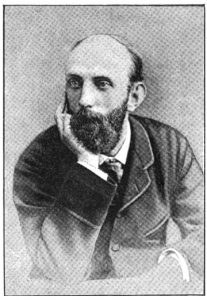
One should be excused for confusing John Strudwick’s art with that of another contemporary female artist of his known as Evelyn De Morgan, so much so that when searching for the former artist’s material on the Internet I stumbled across a few images of paintings which were wrongly attributed to him, but in reality had been created by the latter artist (thanks Pinterest), also paintings by Edward Burne-Jones, another painter strongly associated with the English artist at hand, could also pass as Strudwick’s work (and vice-versa). Yet another contemporary artist like John Roddam Spencer Stanhope should spring to mind due to the similarities in aesthetics and artistic technique.
John Melhuish Strudwick’s forte was his representation of young females of placid demeanour and unattainable beauty (basically of an ethereal or “angelic” nature) many times depicted lost in contemplation, like the protagonist in one of my favourite paintings by Strudwick entitled Elaine (1891) a painting inspired by the Arthurian story Idylls of the King (1859) where romantic love and tragedy seem to take a high level of transcendence.
Aesthetically speaking Strudwick’s paintings were driven by an ideal vision of The Renaissance and the Middle Ages. He did not produce many artworks presumably due to his excessive attention for details (which becomes immediately apparent when looking at many of his paintings) and for the fact that, at some point, he was “ditched” by his patrons, a couple of wealthy industrialists known as William Imrie and George Holt. This was one of the issues that unfortunately put a definitive end to Strudwick’s artistic career.
George Bernard Shaw wrote an article on Strudwick for the Art Journal of 1891 in which he wrote: “transcendent expressiveness is the moving quality in all Strudwick’s works and persons who are sensitive to it will take almost as a matter of course the charm of the architecture, the bits of landscape, the elaborately beautiful foliage, the ornamental accessories of all sorts, which would distinguish them even in a gallery of early Italian paintings”. From ‘To Honor Old Masters: John Melhuish Strudwick’ by fineartnow (steemit)

As an online biography on Strudwick I would highly recommend the one I found on Madeleine Emerald Thiele’s website from which I have extracted the next short excerpts. As the authoress of this essay explains the term “The Last of The Pre-Raphaelites” is a bit of a stretch since that same term has been attributed in the past to other meritorious artists such as Burne-Jones and Cadogan Cowper for instance. Whatever the case might be I believe that -at least- Strudwick has been the last Pre-Raphaelist to be (re)discovered in the current era:
“Little detail or attention is given to Victorian artist, John Melhuish Strudwick (1849-1937). A portrait of Strudwick by Frederick Hollyer (1890) can be found in the V&A collection but it is not available on their website and although it is accessible to those who subscribe to the Oxford Dictionary National Biography, it cannot be reproduced from there because of legal restrictions. Thus Strudwick remains elusive.”
“However, when it comes to rarely discussed artists, such as Strudwick, digital replication is a promising sign: particularly when we consider the merit an obituarist afforded him when he commented that Strudwick ‘must have been the last of the Pre-Raphaelites’.”
“Strudwick’s retirement in 1909 suggests a certain amount of dissatisfaction, particularly when he lived for a further thirty years. Landow even describes the unfinished 1910 work ‘When Sorrow comes in Summer Days, Roses Bloom in Vain’ as ‘an indication of the disillusionment he [Strudwick] felt at the collapse of his career’. Certainly by 1910 the Pre-Raphaelite style was unfashionable, and artists such as Frank Cadogan Cowper can also be seen struggling with similar issues. Their mock / late / inherited Pre-Raphaelite style was considered outmoded and outdated. Picasso, Braque, Cezanne etc. had all invigorated art and the centre was definitely Paris, not London… So perhaps it was age coupled with an awareness of the changing times which made Strudwick put his paintbrushes away.”
Sources: fineartnow (steemit), Madeleine Emerald Thiele, wikipedia, artnet, and Le Prince Lointain [kaput].
If you have enjoyed this article please consider the idea of donating some shillings to its author. They will be greatly appreciated in these times of scarcity. Cheers.
 RSS Feed
RSS Feed















 August 25th, 2020
August 25th, 2020  Awake Goy
Awake Goy  Posted in
Posted in  Tags:
Tags: 













